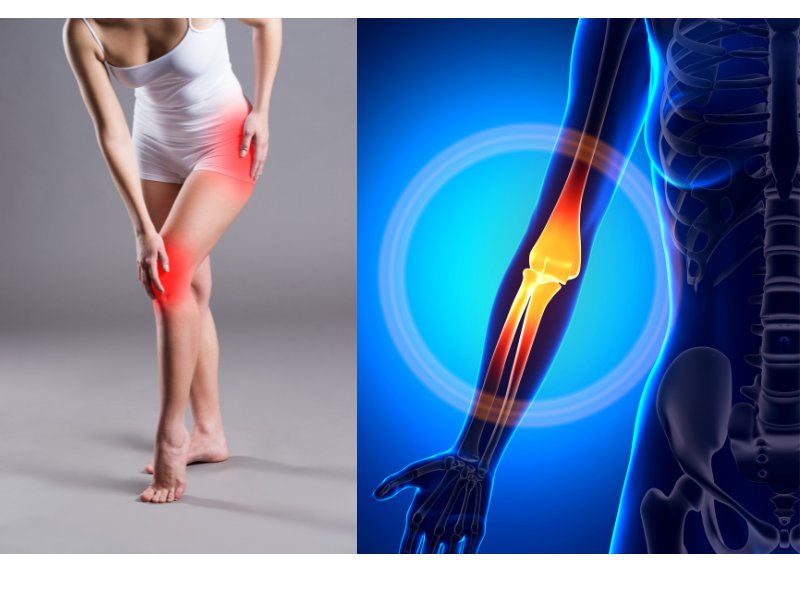Arthritis: Symptoms, Causes, Types and Treatment

Arthritis is quite common, particularly in adults over the age of 50. It causes pain, stiffness, and inflammation in the joints. Your physician will assist you in determining the type of arthritis you have, what is causing it, and which therapies you will require. If you have severe arthritis that is not responding to other therapies, you may require a joint replacement.
What is arthritis?
Arthritis is a condition that leads to inflammation of one or more joints. Joint inflammation results in pain, swelling, stiffness, and decreased joint mobility.
As you age, some joints naturally undergo wear and tear, leading many individuals to develop arthritis. While arthritis predominantly affects the elderly, it can also impact people of all ages, including children.
The most prevalent form, osteoarthritis, stems from the wear and tear of joint cartilage over time. Other types, such as rheumatoid arthritis and gout, involve autoimmune responses or metabolic disturbances.
Symptoms of Arthritis
The most common symptoms involve the joints. Depending on the type of arthritis, symptoms may include:
- Stiffness or reduced mobility
- Sensitivity to touch around the joint
- Joint pain
- Swelling
- Decreased range of motion
- Skin discoloration
- Redness
Arthritis can affect any joint. However, it’s most common in:
· Knees
· Shoulder
· Hips
· Hands and wrist
· Lower back
· Feet and ankles
Causes of Arthritis
The primary cause of arthritis varies depending on the type:
1. Osteoarthritis: Develops naturally with age, as a lifetime of joint use can wear down the cartilage cushioning.
2. Gout: Occurs when there is an excess of uric acid in the blood (hyperuricemia).
3. Immune System: Disorders like rheumatoid arthritis are caused when the immune system mistakenly damages the joints.
4. Viral Infections: Certain viral infections, including COVID-19, can trigger viral arthritis.
5. Idiopathic Arthritis: In some cases, arthritis occurs without a specific cause or trigger, referred to as idiopathic arthritis.
Types of Arthritis
Arthritis manifests in various forms, each demanding a unique approach:
1. Osteoarthritis (OA): The most prevalent type, OA occurs when joint cartilage breaks down. This causes the bones to rub against each other.
2. Rheumatoid Arthritis (RA): An autoimmune disorder where the immune system attacks joint linings, leading to inflammation.
3. Psoriatic Arthritis: Associated with psoriasis. This type affects both skin and joints.
4. Gout: Characterized by the accumulation of uric acid crystals in joints. Gout can cause sudden, intense pain.
5. Ankylosing Spondylitis: Primarily affects the spine. This inflammatory arthritis can lead to fused vertebrae.
Risk Factors for Arthritis
1. Family History: Some types of arthritis have a familial tendency. This increases your risk if close relatives like parents or siblings have the disorder.
2. Age: The risk of various types of arthritis, such as osteoarthritis, rheumatoid arthritis, and gout, tends to rise with age.
3. Gender: Rheumatoid arthritis is more common in women. Gout is more prevalent in men.
4. Previous Joint Injury: Individuals who have experienced joint injuries are more prone to developing arthritis in those joints.
5. Obesity: Carrying excess weight adds stress to joints. Areas like the knees, hips, and spine increase the risk of arthritis development.
Treatment Approaches for Arthritis
Managing arthritis involves several approaches. These approaches aim at easing the symptoms and improving joint function. Key elements of arthritis treatment include:
1. Medications: Anti-inflammatory drugs, pain relievers, and disease-modifying antirheumatic drugs (DMARDs) are commonly prescribed.
2. Physical Therapy: Exercises and stretches can enhance joint flexibility and reduce stiffness.
3. Lifestyle Modifications: Maintaining a healthy weight, regular exercise, and joint protection strategies are crucial.
4. Surgery: In severe cases, joint replacement surgery may be considered to relieve pain and restore function.



